Stavros Halvatzis's Blog, page 45
September 13, 2015
Why Do You Write?
 Why do we write? This important question has been asked countless of times.
Why do we write? This important question has been asked countless of times.
The response is probably as varied as the people asking it, ranging from the rather vague – I write because I have to, to the more pragmatic – it helps pay the bills.
But writing is such a difficult and lonely activity that I believe there has to be a deeper and more significant reason that explains why we keep returning to our keyboards.
Why is it important to know? Because when we lose our way – and sooner or later we all do, when the muse and market-place glance the other way, when the critics descend upon us like a plague of locusts – we need to grab hold of that reason and use it to help pull ourselves back up to higher ground.
“It pays the bills,” won’t do then. There are other easier ways to pay the bills. Neither will, “I write because I have to,” since during such times it doesn’t feel like you have to at all.
The answer is probably two-fold. The first part is true for most writers: realise that what you’re feeling now will inevitably change. Your strength and self-belief in your abilities will return, prompted by more positive reviews, fresh insights, wonderful new ideas, better sales.
The second part you have to work out for yourself. What is it about the craft of writing, specifically, that brought you to the deep well in the first place? Remember that feeling you had when you wrote that first paragraph, page, chapter, that got you hooked.
For me it was a short story I wrote for a school assignment about the unbounded joy a homeless kid feels when he finds a shiny coin in the street. The idea sprang out of nowhere and practically wrote itself. I remember that last line well. It said: “And in his little black hand, the shiny 50 cent piece was set off even more.” Naive as it was, it had heart and a social conscience beyond my conscious ability to craft it.
The story made it to the school’s end-of-year magazine and proved to me that there was a voice inside me that had something to say if I could just find a way to activate it. It was the start of my journey.
I’m sure you have an equally meaningful memory about the moment when you first realised that you had something to say. Remind yourself of it when the going gets tough. It may just help you get back on track.
Summary
Never forget the moment when you first realised you had something to say as a writer.
Invitation
If you enjoyed this post, kindly share it with others. If you have a suggestion for a future one, please leave a comment and let’s get chatting. You may subscribe to this blog by clicking on the “subscribe” or “profile” link on the bottom right-hand side of this article. I post new material every Monday.
September 6, 2015
Do Your Characters Have ‘Felt Life?’
 One piece of writing advice we keep hearing over and over again is that the characters in our stories should be authentic – that they should exude a sense of verisimilitude.
One piece of writing advice we keep hearing over and over again is that the characters in our stories should be authentic – that they should exude a sense of verisimilitude.
But this is easier said than done. It takes years of meticulous observation of people to grow a sufficient understanding of their motives, fears, hopes, and goals, and even then, there’s no guarantee that this understanding can be communicated through a story in a way that makes it feel authentic. If that were the case, EVERY lawyer or psychologist would automatically become a bestselling author or Oscar-winning screenwriter. There have been some successful writers emanating from those illustrious professions, but by no means all. Why?
The truth is that writing requires techniques specific to the art of writing. Technique, in this sense, is the method of distilling an author’s experience of the world into a story that convinces the reader of its authenticity.
One way to achieve this is to imbue your characters with a sense of ‘felt life.’ The idea is to have your characters effervesce a pervasive sense of their likes, dislikes, values, and individual memories and foibles, so that they spring to life.
Here’s an example, drawn from my latest book, The Nostalgia of Time Travel, in which the protagonist, Benjamin Vlahos, describes his love for a specific cafe located in Mission Beach on Australia’s east coast:
“There is a small cafe off the beaten path near Mission Beach in the north that makes the best waffles I’ve ever tasted. Miranda and I once had breakfast there, as newlyweds, while on a tour across Australia and the place stuck with me; but that was a long time ago.
These days you know the shop is there, even though it’s hidden by trees and shrubs and clamping bamboo that sways five metres tall, because the scent of freshly ground Brazilian coffee can keep no secrets.
The tables, now mostly vacant, are covered with green tablecloths with cigarette burns. The chairs have thatch seats that creak when you sit down, though never enough to spoil the constant stream of blues and jazz on vinyl from a Philips turntable. The walls are strewn with dusty black and white photographs of the town before they found coal, a few kilometres up the road.
Not many people drift into O’Hara’s anymore. They built a pier nearby with the coal money and a three-level shopping centre, with more parking than there are people in the town. It’s filled with glass and chrome restaurants, bars and shops, and the place now draws much of the crowd away. I’m still a regular customer though.”
Benjamin’s sense of nostalgia, his love for Brazilian coffee, and his tacit condemnation of the new shopping centre, built out of coal money, which has more parking than there are people in the town, grants us an effective and concise snapshot of his personality – a sense of ‘felt life’ which gives the story its verisimilitude.
Summary
Make your characters more authentic by imbuing them with a sense of ‘felt life.’
Invitation
If you enjoyed this post, kindly share it with others. If you have a suggestion for a future one, please leave a comment and let’s get chatting. You may subscribe to this blog by clicking on the “subscribe” or “profile” link on the bottom right-hand side of this article. I post new material every Monday.
August 23, 2015
Why Put Up Your Book For Free?
The Nostalgia of Time Travel
It’s been a while since I used Amazon’s KDP option of putting up a book for free for a few days as a marketing strategy for my novels. In the old days, if your book did well in the get-for-free list, its ranking was transferred to the pay-to-read list.But since then Amazon has tightened its algorithms. The do-well affect is not as transferable. So why offer your book, whose creation is a torturous and labour intensive task, often spanning months, for free?
Well, for one, it gets your work read. Amazon still calls the shots in the indie world in terms of spread and reach. Obscurity is akin to oblivion for a writer. Rather have people read and (hopefully) enjoy your book than have it wallow in the darkness among the millions of other books that are never discovered.
Secondly, there is always a chance that some kind souls who have harvested your book for free will find it in their hearts to review it and post the reviews up on Amazon. As we all know, reviews are like gold dust to indie writers.
Thirdly, a widely popular book on the read-for-free list, does enjoy some spill off effect. Maybe not a torrent, maybe not a gush, but definitely a leak.
It is for these and other reasons that I decided to put up my latest book, The Nostalgia of Time Travel, a novelette, for free on Amazon for a period of three days. Within two days, Nostalgia had shot up the lists — #3 in the Metaphysical bestseller category, and #4 in Fiction and Literature!
So far so good.
But, again, the nagging question persists: Will the book’s popularity endure? Time will tell.
Needless to say I’ll be reporting on The Nostalgia of Time Travel’s bid for prominence, in the near future. Watch this space, because if it works for me, it can work for you!
Summary
Offering your book for free for a few days on Amazon may help get it noticed.
Invitation
If you enjoyed this post, kindly share it with others. If you have a suggestion for a future one, please leave a comment and let’s get chatting. You may subscribe to this blog by clicking on the “subscribe” or “profile” link on the bottom right-hand side of this article. I post new material every Monday.
August 16, 2015
Who Are The Point-of-View Characters in Your Story?
 A screenplay or novel is typically filled with several characters, in addition to the protagonist. One of our tasks as writers is to know who the viewpoint characters of our story are going to be.
A screenplay or novel is typically filled with several characters, in addition to the protagonist. One of our tasks as writers is to know who the viewpoint characters of our story are going to be.
Here’s a short list, drawn from Margret Geraghty’s The Novelist’s Guide, on who they are and how to craft them:
1. Ask yourself: which of my characters have the biggest stake in the story I’m trying to tell? Have the most to lose? Care most passionately about solving the story-problem? Your answers will indicate who your point-of-view characters are.
In The Land Below, Paulie is the character with the biggest responsibility and with the most to lose. But the Troubadour, too, has high stakes centered around a secret he has kept from Paulie all these years. Both are point-of-view characters who seize and hold our interest.
2. Which characters are the most interesting? The most intriguing? These are the characters the reader or audience wants to know most about.
3. Which of the characters are most involved in driving the action and the story forward? Passive characters are the least interesting and tend to slow the story down.
4. Which characters are the most complicated? Complex characters hold our attention through their unpredictability, complexity and depth. In The Nostalgia of Time Travel, Benjamin Vlahos is such a character in the sense that we are uncertain whether he will choose to live or die by the end of the story.
Point-of-view characters are indispensable in creating interest, intrigue, and movement in our stories. They are the vehicles through which our readers and audience experience the story.
Summary
Craft point-of-view characters by making them complex, interesting, active, and with the most to lose.
Invitation
If you enjoyed this post, kindly share it with others. If you have a suggestion for a future one, please leave a comment and let’s get chatting. You may subscribe to this blog by clicking on the “subscribe” or “profile” link on the bottom right-hand side of this article. I post new material every Monday.
August 9, 2015
The Nostalgia of Time Travel
The Nostalgia of Time Travel
 This post is unashamedly about my latest novelette, The Nostalgia of Time Travel. The novelette represents a new departure from my usual writing, although I’ve tried to keep external events that are at the core of every genre-driven tale a strong feature of this story.
This post is unashamedly about my latest novelette, The Nostalgia of Time Travel. The novelette represents a new departure from my usual writing, although I’ve tried to keep external events that are at the core of every genre-driven tale a strong feature of this story.
The novelette is part of my ongoing attempt to bring a more authentic, literary approach to my stories while still managing to retain a strong outer journey—something I began exploring in my previous novel, The Land Below.
Here’s a short description of The Nostalgia of Time Travel:
After the accidental death of his wife, Miranda, Benjamin Vlahos, an American theoretical physicist relocates to a remote resort town in Northern Queensland to work on a set of equations to prove that time travel to the past is possible. As he struggles with the math, a deadly cyclone approaches, dragging with it ghosts from an unresolved past.
As always, I’ve worked with nuggets mined from different genres in an attempt to keep the story fresh and unpredictable, but I’ve taken extra care to keep the emotional and psychological dimensions authentic.
Here’s an early indication from the first Amazon.com review. I’d love to hear from others whether you think I’ve succeeded.
It’s a book for people who enjoy exploring the complexities of human nature
By hannah on August 8, 2015
Format: Kindle Edition Verified Purchase
A thought provoking novel, that excels at creating a rich, layered world for his characters, with lines you want to read out loud, just to hear them. It’s more of a book for people who enjoy exploring the complexities of human nature, rather then just a waiting for the next plot point.
Invitation
If you enjoyed this post, kindly share it with others. If you have a suggestion for a future one, please leave a comment and let’s get chatting. You may subscribe to this blog by clicking on the “subscribe” or “profile” link on the bottom right-hand side of this article. I post new material every Monday.
August 2, 2015
Do You Like Your Stories Up Close and Personal?
 Continuing from last week’s article drawn from Margaret Geraghty’s The Novelists’s Guide, we look at the pros and cons of using the first-person technique in storytelling.
Continuing from last week’s article drawn from Margaret Geraghty’s The Novelists’s Guide, we look at the pros and cons of using the first-person technique in storytelling.
Despite its restrictions, the technique has many strengths to commend it.
When The Catcher in the Rye was first published in 1951 readers were so convinced of the actual existence of Holden Caulfield, the story’s fictitious narrator, that they scoured the streets to find him. The author’s use of youthful speech patterns, exaggeration, present tense, and slang imbued the work with a sense of fluency and authenticity that would be hard to create through the more common third person past tense narrative.
The Nostalgia of Time Travel, my soon to be released novella, concerns the struggle of an aging theoretical physicist, Benjamin Vlahos, to unite two grand theories – General Relativity and Quantum Mechanics – in one grand theory of everything.
Additionally, Benjamin is haunted by the loss of his wife that occurred thirty years previously, blaming himself for inadvertently creating the chain of events that led to her death. To make matters worse, one of the most powerful cyclones to ever threaten the coast of Northern Queensland in Australia is closing in.
As these events wind ever closer together, interspersed with fragments of memory, theoretical speculation, and a haunting sense of loss, the narrative becomes increasingly nostalgic, ethereal, and tense.
I chose to use the first person present tense for the following reasons:
1. The technique lends itself to a colloquial style which encourages a sense of collusion between the reader and Benjamin. We are made privy to Benjamin’s hopes and fears in a more immediate and direct way than is otherwise possible.
2. Because this style uses natural, fluent, speech patterns, it is less likely to descend into pretension, pompousness, and purple prose. It is also a lot easier to read.
3. Since I’m addressing the reader directly, I do not need to use intrusive speech tags. This suits a story of introspection that is driven by emotion and the tension of physical peril caused by the approaching storm.
4. Secondary characters are richer precisely because they are projected from a single viewpoint. When the young Benjamin, thinking back to his youth, says of his uncle, ‘I wished I was bigger so I could pack his bag and shove him out of the house,’ we experience this through the eyes of a six year old child and forgive him his prejudice.
5. On the down side, the protagonist has to be in every scene and the thoughts and feelings of other characters have to be filtered through his viewpoint. But again, because characters are experienced through the heart and mind of our protagonist, we are given more opportunities to explore his soul through his misunderstandings, and through irony, pathos, and humour.
5. Another criticism is that the technique forces the repetitive use of ‘I’. In The Nostalgia of Time Travel, however, the frequent use of the word adds to the sense of pathos, stasis, and eccentricity of the protagonist, as seen below:
‘I wipe my reading glasses with my handkerchief to ensure they are free of smudges, squeeze them back on my face, and tilt my equations this way and that. I dot my i’s and cross my t’s. I make sure my pluses are not really minuses resulting from a lack of concentration. I sip another cup of coffee and spread more syrup over my waffles before I study the math again.’
Summary
Use first person, present tense narration to invoke a powerful sense of authenticity, immediacy and intimacy.
Invitation
If you enjoyed this post, kindly share it with others. If you have a suggestion for a future one, please leave a comment and let’s get chatting. You may subscribe to this blog by clicking on the “subscribe” or “profile” link on the bottom right-hand side of this article. I post new material every Monday.
July 26, 2015
A Writer’s Perspective
 In her book, The Novelist’s Guide, Margret Geraghty, stresses that choosing your story’s perspective or viewpoint, is one of the first and most important decisions you make as storyteller and novelist.
In her book, The Novelist’s Guide, Margret Geraghty, stresses that choosing your story’s perspective or viewpoint, is one of the first and most important decisions you make as storyteller and novelist.
Do you write from the first person or third person perspective? Do you use an omniscient narrator, or a flawed narrator that is a character in the story, like Nick Caraway in The Great Gatsby?
Your choice of viewpoint will not only affect the tone of your story, but the reader’s emotional response to it too.
Additionally, a radical change of viewpoint can allow the writer to mine many existing and beloved stories, generating countless adaptations.
A change of viewpoint can turn Jack and the Beanstalk into a tale about the home invasion of a sensitive, shy giant at the mercy of a rag-tag boy that has snuck into his home.
Or, Cinderella, in a reimagined version, can trace the sorry lot of an ugly sister, hopelessly outgunned and outshone by a shallow, foul-mouthed bimbo who can’t stop talking about fine clothes and marrying the prince.
How about the changes in emotion that would occur in a story of adultery told through the adulterer’s eyes and then retold through the victim’s? How would our sympathies shift through this he-said, she-said approach?
Perspective favours the character who owns it, although it can also allow for characters who are filled with self-loathing or pity whom we tend to judge more critically. The point still stands: Choosing the right perspective is integral to the tone, theme, and the emotional commitment of your readers to your characters and story.
Summary
Choosing you story’s viewpoint is one of the first and most important decisions you make as a writer.
Invitation
If you enjoyed this post, kindly share it with others. If you have a suggestion for a future one, please leave a comment and let’s get chatting. You may subscribe to this blog by clicking on the “subscribe” or “profile” link on the bottom right-hand side of this article. I post new material every Monday.
July 19, 2015
How Location Impacts Character
 Staying with Linda Seger’s, Creating Unforgettable Characters, we learn about the impact that location has on character.
Staying with Linda Seger’s, Creating Unforgettable Characters, we learn about the impact that location has on character.
My usual advice to my students is to write about what they know in order to retain the sense of verisimilitude of characters and locations — but this is not always possible. You may need a scene to play out in a country you never visited, or include a character you’ve never encountered for real — after all, I don’t know about you, but I can’t place the last time I chatted to a Martian.
That’s where research and a sensitive imagination come in. For make no mistake, location deeply influences many aspects of character. The energetic rhythm of Philadelphia in Witness, differs from the slow paced life on an Amish farm. The speech patterns of New York’s Working Girl differ from those of the West in Electric Horseman.
If you were writing The Power and the Glory, by Graham Greene, you would want use your knowledge of the oppressive heat, humidity, and constant rain in the tropics in order to capture your characters’ sense of oppression and claustrophobia.
If you were writing One Flew Over the Cuckoo’s Nest you would need, like Dale Wasserman who wrote the play based on Ken Kesey’s novel, to visit several asylums. Dale even arranged with one cooperative psychiatrist to have himself committed in order to do undercover research close up.
In my forthcoming novella, The Nostalgia of Time Travel, my protagonist, Benjamin Vlahos, lives in Mission Beach on Northern Queensland’s tropical coast. The heat, dress, and even the way houses are constructed to withstand the cyclones of the region are integral to the authentic rendition of the story. I spend several years in the area and lived through one category five cyclone, so additional research was minimal.
The advice is sound: Write about places and people you know. Failing that, conduct research by visiting the actual locations you intend to render, or watch as many documentaries on the area, and do as many interviews with the people that are familiar with it, as you can. Your writing will be more authentic for it.
Summary
Write about places and people you know. Fill in the gaps by conducting rigorous research.
Invitation
If you enjoyed this post, kindly share it with others. If you have a suggestion for a future one, please leave a comment and let’s get chatting. You may subscribe to this blog by clicking on the “subscribe” or “profile” link on the bottom right-hand side of this article. I post new material every Monday.
July 12, 2015
Why Writers are Dr. Frankensteins
 People often ask writers: Where do your characters come from? Where do you look for them? How do you select them?
People often ask writers: Where do your characters come from? Where do you look for them? How do you select them?
The truth is that characters are most often stitched together from bits and pieces inspired by the people we have met, united by a common premise and animated by the necessities of plot.
And, like Dr. Frankenstein, writers pour themselves into their creation. We infuse our characters with our spirit and have them play out our hopes and fears.
But like Frankenstein’s monster, our creations sometimes rebel. They take on a life of their own. The result is no longer the sum of its parts. This is when our voice takes over, shaping the narrative. Some call this the muse. For me, this voice is a phantom conductor molding the numerous notes into a seamless symphony.
In my forthcoming novel, The Nostalgia of Time Travel, Benjamin Vlahos, is a man struggling to marry Quantum Theory with General Relativity. At the same time, he is haunted by the death of his wife, a tragedy that occurred years previously – something he never got over.
My protagonist is drawn from many sources. A beloved math teacher in high school, a cousin in Greece, friends and neighbours in South Africa, England and Australia, several famous physicists whose biographies I have studied. There are even elements of myself in him. My love for mathematics, relativity theory, and quantum mechanics is no secret.
But ultimately, the character will remain a corpse unless I breathe life into him. This breath typically takes the form of bestowing him with human purpose.
In The Nostalgia of Time Travel, Benjamin Vlahos has one impossible goal. To travel back to the past and prevent his wife from dying. It is this inner obsession that brings the disparate aspects of his personality together and drives the story forward. Without it Benjamin is a mere assemblage of traits serving the plot.
Summary
Assemble your characters from a variety of sources, but infuse them with life by providing them with a powerful purpose.
Invitation
If you enjoyed this post, kindly share it with others. If you have a suggestion for a future one, please leave a comment and let’s get chatting. You may subscribe to this blog by clicking on the “subscribe” or “profile” link on the bottom right-hand side of this article. I post new material every Monday.
July 5, 2015
Unlocking Character Through Backstory
 Most novels or screenplays focus on one specific story. Linda Seger, in her book, Creating a unforgettable Characters, calls this the front story. This is the actual story the writer wants to tell.
Most novels or screenplays focus on one specific story. Linda Seger, in her book, Creating a unforgettable Characters, calls this the front story. This is the actual story the writer wants to tell.
But in order to successfully tell this story we need to understand the reasons the characters act in the way they do. We need to understand the traumas, delights, and crisis of their childhood, the challenges of their adult life — we need to understand their past.
The backstory grants us two types of information leading to such an understanding.
One is of past occurrences that impact the construction of the story. Hamlet and Citizen Kane have backstories we need to understand to make sense of the story.
Other information forms part of the character biography. This information is never directly given to us, but understanding the attitudes and values of a character through action or dialogue, allows us to predict and understand their motivation.
In Unforgiven, a deputy discusses the Sheriff’s toughness in a conversation with other deputies: “Little Bill Scared? Little Brill grew up in the streets of Kansas. Little Bill ain’t scared. He’s just no carpenter.” Little Bill Daggett’s obsession with his roof and lack of carpentry skill reflects his failure to prevent the rain from getting into his house. It speaks to a deeper flaw — his failure to keep other elements from entering into his life; it hints at his forthcoming death, resulting from his inability to keep Will Manny out of his town.
Both types of information flows, then, serve an important function – supporting the forward story through the timeous release of essential details that explains character behavior.
Summary
Use backstory techniques to motivate and explain character actions.




